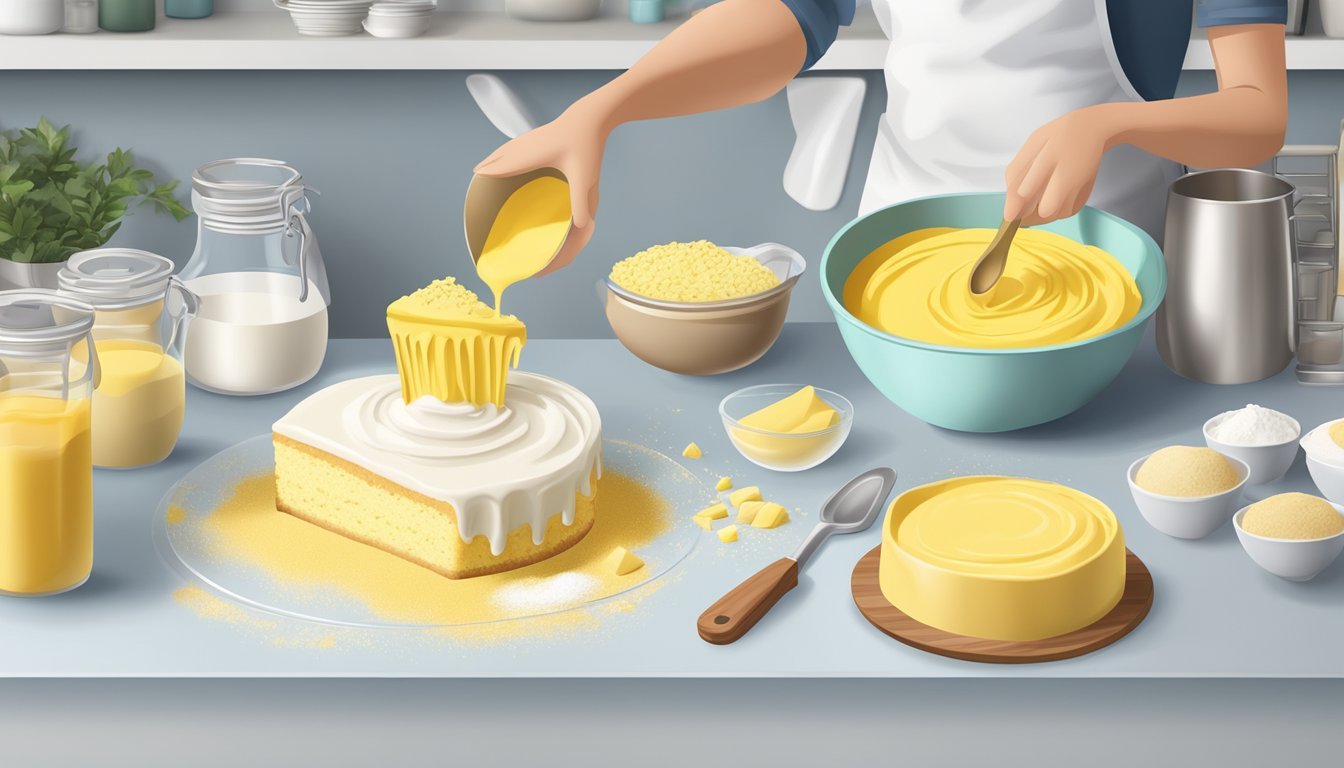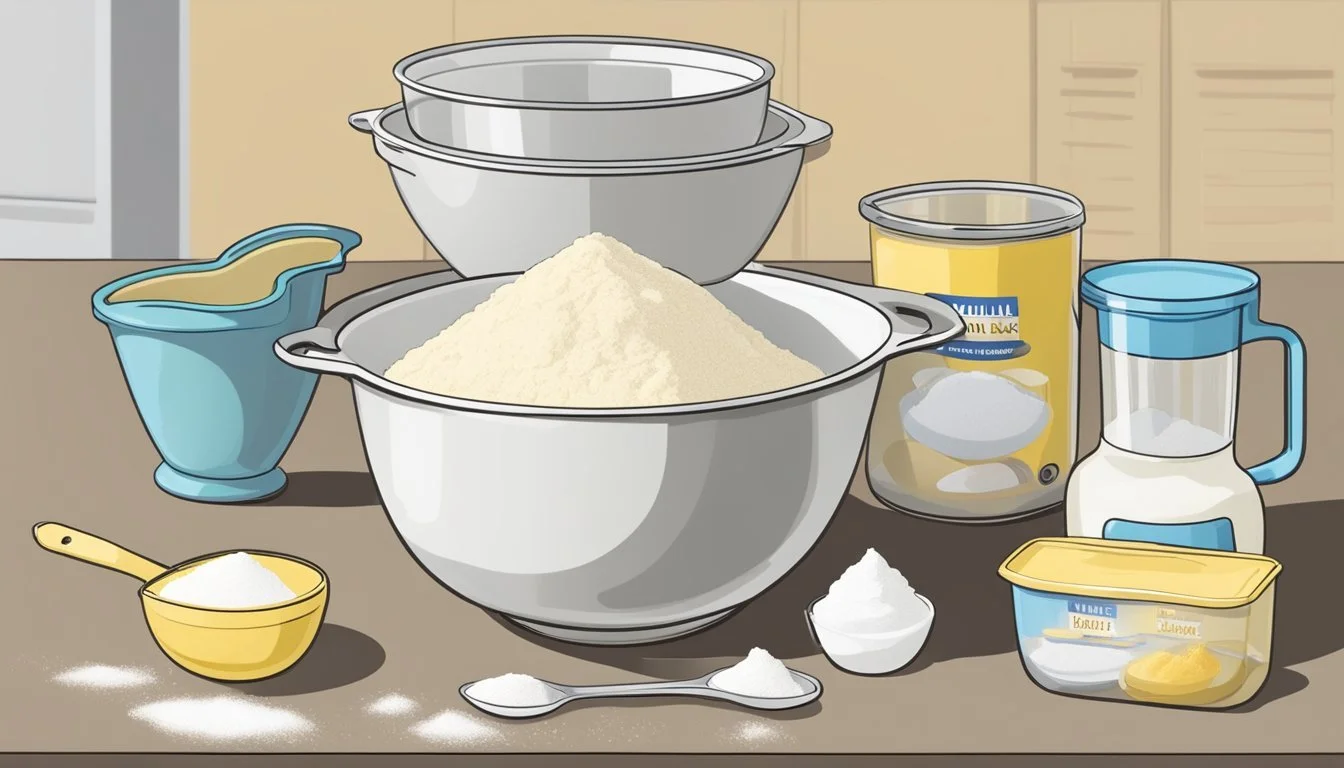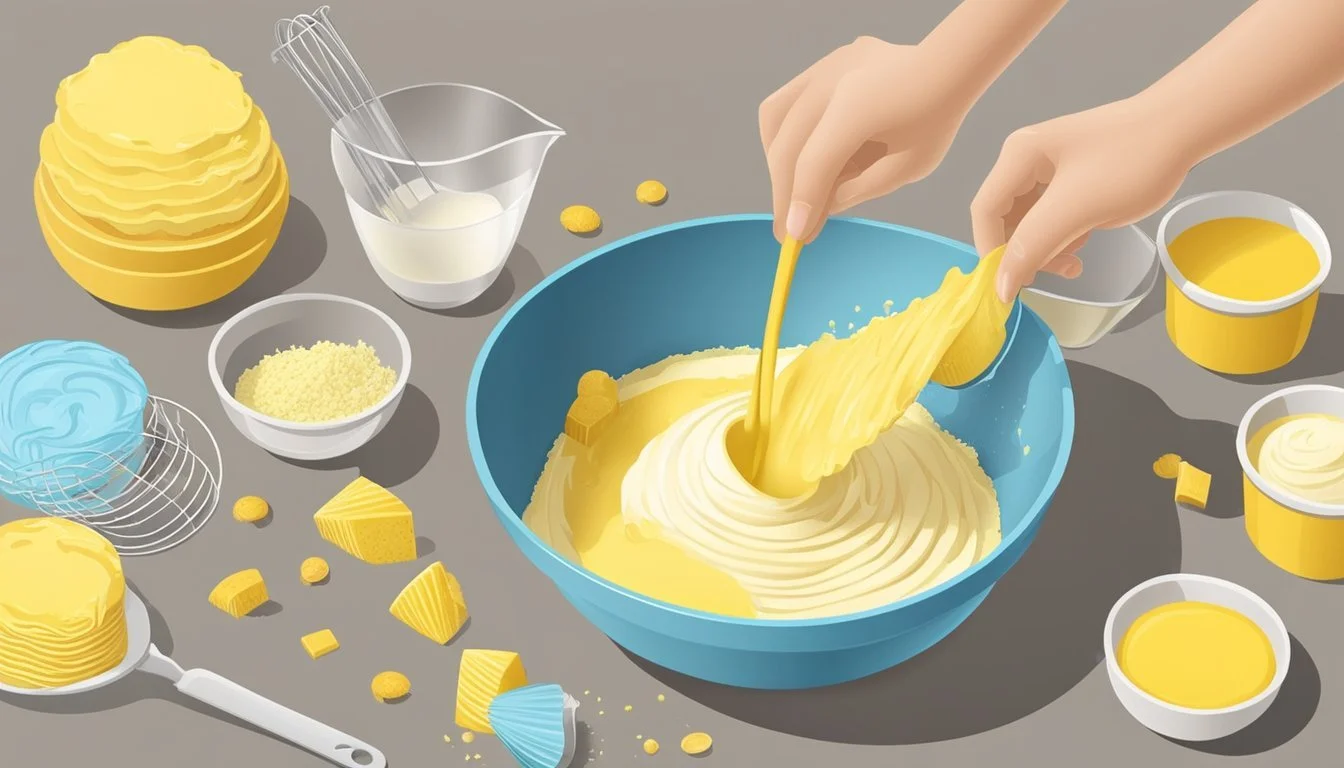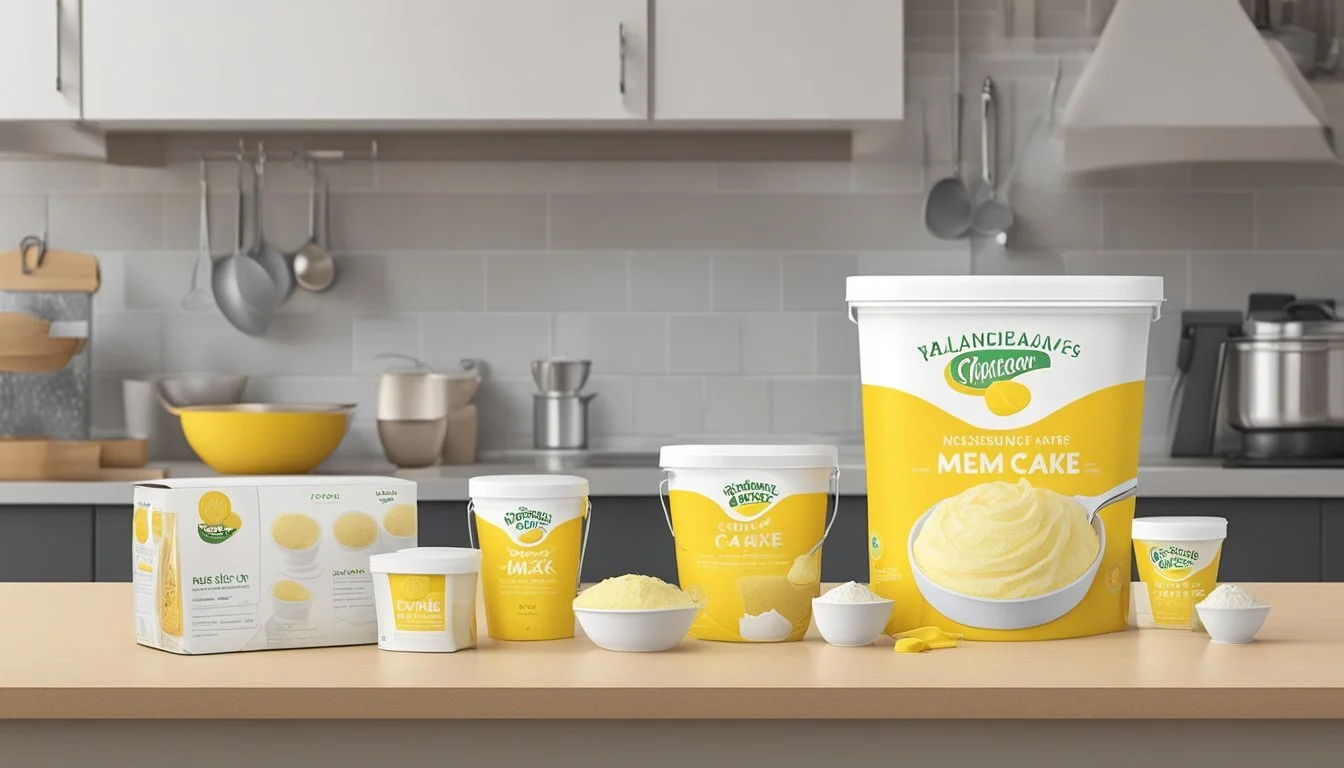How to Substitute Yellow Cake Mix for White Cake Mix
A Simple Switch Guide
In the vast world of baking, cake mixes stand as a convenient and reliable choice for creating a variety of sweet treats with ease. Among these, white and yellow cake mixes are prominent staples, with each one serving as the foundation for countless dessert recipes. At times, a baker may find themselves with a recipe that calls for white cake mix while only having yellow mix on hand. Fortunately, with a clear understanding of their differences and similarities, it's entirely possible to use yellow cake mix as a substitute for white cake mix without compromising the quality of the final product.
The primary distinction between yellow and white cake mixes lies in the ingredients that give them their namesake hues. Yellow cake mix typically includes egg yolks, which impart a richer flavor and the characteristic golden color. White cake mix, by contrast, usually involves only egg whites and no yolks, leading to a lighter texture and a pure white appearance when baked. When substituting yellow cake mix in place of white, the outcome may have a slight variation in color and taste, but these differences are often subtle and unlikely to affect the enjoyment of the baked goods.
Substitution is a simple process: in most instances, yellow cake mix can be directly swapped in for white mix. For those desiring to closely mimic the qualities of a white cake, adjustments can be made, such as using only egg whites instead of whole eggs, or incorporating a teaspoon of vanilla extract to enhance flavor. With tiny tweaks like these, the adapted recipe can yield a dessert that satisfies the expectations for recipes initially designed for white cake mix. Bakers can carry out this substitution with confidence, knowing they can produce delightful results, even when improvising in the kitchen.
Understanding Cake Mix Basics
When baking, the small differences in ingredients can significantly influence the texture and flavor of the finished product. This is particularly true when swapping white cake mix for yellow cake mix, as both have distinct compositions and uses in baking.
Composition of White and Yellow Cake Mixes
White and yellow cake mixes share several key ingredients, but their proportions and one specific ingredient—egg yolks—differ. White cake mix typically consists of:
All-purpose flour: Provides structure
Granulated sugar: Adds sweetness and tenderizes
Baking powder: Acts as a leavening agent to help the cake rise
Salt: Balances the flavors
In contrast, yellow cake mix contains similar ingredients with the addition of egg yolks. These contribute to the mix's golden color and add richness to the cake's flavor.
The Role of Eggs in Cake Mixes
Eggs are essential in cake mixes, serving multiple functions:
Structure: Proteins in eggs give cakes (how long do cakes last?) firmness.
Leavening: Eggs help the cake to rise.
Moisture: They contribute to the cake's moisture content.
Emulsifying: Eggs help in blending water- and fat-based ingredients.
The primary difference between white and yellow cake mixes is that white cake mix uses only egg whites, while yellow cake mix includes both egg whites and egg yolks. The egg yolks enhance the cake's moisture and tend to create a more tender crumb.
Baking Fundamentals
Successful substitution of yellow cake mix for white requires maintaining the proper balance in the following areas:
Measurements: Accurate measuring of flour, sugar, baking powder, and salt is critical.
Mixing: Overmixing can lead to a dense cake, while undermixing can result in an uneven crumb.
Baking temperature: Most cakes bake well at 350 degrees Fahrenheit in a preheated oven.
Testing for doneness: Insert a toothpick into the center of the cake; it should come out clean when the cake is fully baked.
Understanding these basics ensures that one can confidently substitute between cake mixes without compromising quality.
Substitution Techniques
When substituting yellow cake mix for white cake mix, the reader must adjust wet ingredients, modify sugar and flavor components, and utilize fats carefully to closely mimic the desired taste and texture of white cake.
Adjusting Wet Ingredients
To modify the yellow cake mix to resemble white cake mix, one starts by altering the wet ingredients. Typically, white cake mix recipes call for egg whites instead of whole eggs to maintain a light color. Water can be replaced with milk or buttermilk for a richer flavor. For example, instead of the 1 1/3 cups of water mentioned in yellow cake mix instructions, use an equivalent amount of milk or buttermilk.
Modifying Sugar and Flavor Components
For the sugar component, ensure to use granulated sugar which is standard for both white and yellow cake mixes. Flavor adjustments can be subtle but significant; add vanilla extract to enhance the flavor profile. Suggested proportions are approximately 1 to 2 teaspoons of vanilla extract, based on the recipe's original flavor intensity.
Utilizing Fats for Texture
The choice of fat is vital in the texture of the cake. While yellow cake mix often suggests the use of vegetable oil, one might opt for butter to replicate the white cake's rich flavor. Use unsalted butter to control the saltiness, especially if the original mix contains salt. Substitute equal amounts of melted butter for the oil the recipe calls for. If a denser texture is preferred, increase the butter by a tablespoon or two.
Practical Tips for Substitution
When substituting yellow cake mix for white, one's focus should be on closely matching the color and flavor profile, ensuring a consistent cake batter, and making necessary adjustments to baking times and temperatures.
Matching Color and Taste
Yellow cake mix typically contains egg yolks, which contribute to its characteristic golden color and rich taste. To mimic these qualities when using white cake mix:
Color: Add 1-2 extra egg yolks to the batter. This will help achieve the yellow hue without altering the texture significantly.
Taste: Incorporate 1 tablespoon of vanilla extract or vanilla sugar to enhance the flavor complexity.
Achieving Desired Consistency
The consistency of the cake batter can affect the final texture of the cake. White cake mixes are designed to be lighter, so to achieve the denser texture of a yellow cake:
Mix the dry white cake mix with all the same wet ingredients called for by the yellow cake mix recipe (water, eggs, oil or butter). If the white mix needs more moisture, add milk instead of water for a richer batter.
Bake Time and Temperature Adjustments
While oven temperatures generally remain the same, slight adjustments in baking time may be needed due to the added ingredients affecting the mixture's moisture level.
Oven Temperature: Maintain the same temperature suggested by the original yellow cake mix recipe, typically around 350°F (175°C).
Baking Time: Start by using the bake time recommended on the white cake mix box. However, check the cake 5 minutes before the timer goes off since added yolks and milk may require a shorter bake time. Use a toothpick inserted into the center of the cake to test for doneness; it should come out clean when the cake is ready.
Making Cake Mix from Scratch
Creating a homemade yellow cake mix from scratch provides a foundation for a variety of dessert recipes. By assembling the dry ingredients in advance, bakers can save time and ensure consistent results with their baked goods.
Homemade Yellow Cake Mix Recipe
A typical homemade yellow cake mix recipe includes all-purpose flour, sugar, and baking powder as the base ingredients. For a standard batch, one might use:
2 1/2 cups all-purpose flour
1 1/2 cups sugar
1/2 cup non-fat dry milk powder
1 tablespoon baking powder
1 teaspoon salt
These ingredients are sifted together to ensure even distribution and to introduce air into the mix, which can result in a lighter, more delicate crumb.
Assembling Dry Ingredients
The correct proportions of flour, sugar, baking powder, and salt are key for the chemical reactions that occur during baking. One can follow these steps to assemble the dry ingredients:
Measure the ingredients carefully, leveling off cups of flour and sugar with a straight edge for accuracy.
Sift the ingredients together twice to combine them thoroughly and to add lightness to the cake mix.
Tip: Always use a fresh, quality baking powder to guarantee a proper rise.
Choosing the Right Containers
The choice of container for storing the homemade yellow cake mix is important for maintaining its freshness and usability. Glass mason jars are often selected for their airtight seal, which can keep the mix fresh for up to six months when stored in a cool, dry pantry. Ideally, one should:
Use clean, dry containers.
Label the jars with the name of the mix and the date of assembly.
Include instructions for preparing the cake batter when giving the mix as a gift.
Storage Example:
Container Seal Type Label Information Storage Duration Mason jar Airtight Mix name, date Up to 6 months
By using the homemade mix, they can quickly prepare the base for a yellow cake, simply by adding the specified wet ingredients when ready to bake.
Alternative Baking Options
In exploring alternative baking options, one can maintain the structure of a cake recipe while introducing flavor variations or making use of ingredients on hand.
Variations with Different Cake Mixes
Chocolate Cake Mix: For a rich and deep flavor, bakers can replace white cake mix with chocolate cake mix. To ensure the cake remains moist, they might add extra sour cream or an additional egg white to the batter.
Lemon Cake Mix: If a citrus-infused dessert is desired, substituting lemon cake mix for the white can provide a zesty twist. Using a bundt pan can add an elegant design to the lemon-flavored cake.
Incorporating Add-ins
Nuts and Coconut: Adding a variety of nuts or shredded coconut to the cake mix can provide a delightful texture and taste. These can be folded into the batter or sprinkled on top before baking.
Chocolate or Buttercream Frosting: To enhance the visual appeal and taste, one can finish the cake with a layer of rich chocolate frosting or smooth buttercream. These are suitable for both cakes and cupcakes, regardless of the type of cake mix used.
Creative Use of Leftover Ingredients
Cake Pan: If a smaller cake pan is all that is available, leftover batter can be used to make a few cupcakes alongside the main cake. This is an efficient way to use all the mix without wasting any.
Brown Sugar: Leftover brown sugar can come in handy as a sprinkle on top of the cake batter before baking, adding a caramelized sweetness to the crust.
By considering these alternatives, the baker becomes flexible in their approach, creating desserts that cater to their taste preferences or the ingredients they have available.
Brands and Label Guidance
When substituting yellow cake mix for white cake mix, it's crucial to select the appropriate brand and understand the information on the product label to ensure a successful adaptation of recipes.
Popular Cake Mix Brands
Betty Crocker and Duncan Hines are two of the most popular brands that offer a variety of store-bought cake mix options, including yellow and white cake mixes. These brands are widely available in most grocery stores and have a reputation for consistent quality.
Interpreting Cake Mix Labels
Reading labels carefully is key when selecting a cake mix for substitution. Manufacturers typically list the ingredients and recommended measurements for optimal results. Here, focus is on the presence of egg yolks in yellow cake mixes, which can affect the color and richness of the cake.
Ingredients List: Check for the inclusion of egg yolks in the store-bought yellow cake mix, which differentiates it from white cake mix.
Recommended Measurements: Pay attention to the label's suggested measuring ratios of additional ingredients like water, oil, or eggs, to ensure the substitution maintains the desired consistency and taste.
Frequently Asked Questions
In this section, one will find detailed solutions to common issues encountered while substituting yellow cake mix for white cake mix, specifically tailored for unique baking conditions and dietary requirements.
Adjusting for High Altitude Baking
When baking at high altitudes, the reduced air pressure can affect the rise of baked goods. Therefore, adjustments are needed. For each cup of cake mix, add an extra 1-2 tablespoons of water. One may also need to raise the baking temperature by 25°F and reduce the baking time to prevent over-expansion and rapid drying.
Substituting with Vegan or Allergy-Friendly Ingredients
For those with dietary restrictions, specific substitutes can replace common allergens or animal products in cake mixes. Replace eggs with a commercial egg substitute or a flaxseed meal mixture (1 tablespoon flaxseed meal with 2.5 tablespoons water for each egg). If avoiding dairy, use soy, almond, or coconut milk in place of powdered milk. For cup vegetable oil, any neutral-flavored oil like canola or sunflower oil works, or one might use melted vegan butter.
Conclusion
In substituting yellow cake mix for white cake mix, bakers can expect a closely similar outcome with subtle flavor and color variations. The primary difference lies in the egg content; yellow cake mix includes egg yolks, contributing to its richness and hue. To adapt a yellow cake mix in recipes originally calling for white cake mix, one can simply use the yellow mix directly, acknowledging the slight change in cake characteristics.
Recommendations for Achieving the Best Results:
For richness and moisture, replace the oil in the recipe with an equivalent amount of melted butter.
Enhance vanilla flavor with an additional teaspoon of pure vanilla extract.
If a lighter color is desired, consider using only egg whites rather than whole eggs.
Summary Points:
Flavoring: Slight differences are negligible; however, extra vanilla can bring the white cake flavor profile closer.
Color: Will not be pure white; opting for egg whites helps achieve a paler result.
Texture: Should remain consistent between the two mixes, maintaining a tender crumb.
In summary, while the adjustment from white to yellow cake mix will slightly affect the flavor and color, these changes are not significant enough to alter the overall enjoyment of the cake. Bakers can confidently substitute one for the other, following the suggested modifications for optimal results. The ability to interchange these mixes increases versatility in baking, ensuring delicious outcomes regardless of the mix at hand.








